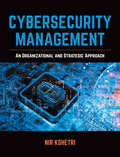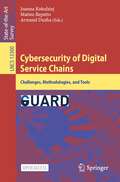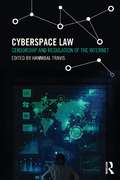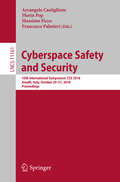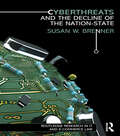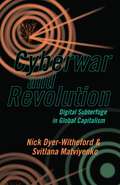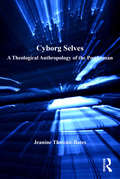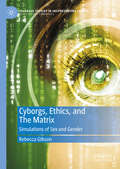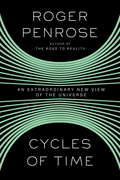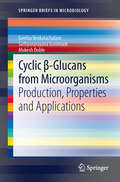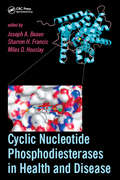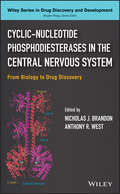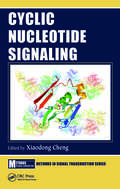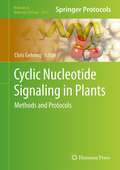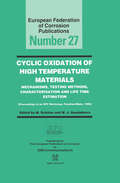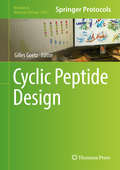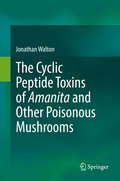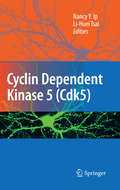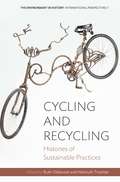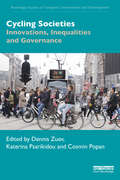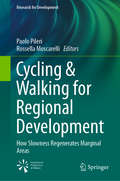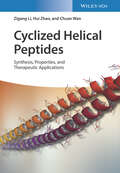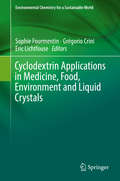- Table View
- List View
Cybersecurity Management: An Organizational and Strategic Approach
by Nir KshetriCyberthreats are among the most critical issues facing the world today. Cybersecurity Management draws on case studies to analyze cybercrime at the macro level, and evaluates the strategic and organizational issues connected to cybersecurity. Cross-disciplinary in its focus, orientation, and scope, this book looks at emerging communication technologies that are currently under development to tackle emerging threats to data privacy. Cybersecurity Management provides insights into the nature and extent of cyberthreats to organizations and consumers, and how such threats evolve with new technological advances and are affected by cultural, organizational, and macro‐environmental factors. Cybersecurity Management articulates the effects of new and evolving information, communication technologies, and systems on cybersecurity and privacy issues. As the COVID-19 pandemic has revealed, we are all dependent on the Internet as a source for not only information but also person-to-person connection, thus our chances of encountering cyberthreats is higher than ever. Cybersecurity Management aims to increase the awareness of and preparedness to handle such threats among policy-makers, planners, and the public.
Cybersecurity of Digital Service Chains: Challenges, Methodologies, and Tools (Lecture Notes in Computer Science #13300)
by Joanna Kołodziej Matteo Repetto Armend DuzhaThis open access book presents the main scientific results from the H2020 GUARD project. The GUARD project aims at filling the current technological gap between software management paradigms and cybersecurity models, the latter still lacking orchestration and agility to effectively address the dynamicity of the former. This book provides a comprehensive review of the main concepts, architectures, algorithms, and non-technical aspects developed during three years of investigation; the description of the Smart Mobility use case developed at the end of the project gives a practical example of how the GUARD platform and related technologies can be deployed in practical scenarios. We expect the book to be interesting for the broad group of researchers, engineers, and professionals daily experiencing the inadequacy of outdated cybersecurity models for modern computing environments and cyber-physical systems.
Cyberspace Law: Censorship and Regulation of the Internet (Routledge Research in Information Technology and E-Commerce Law)
by Hannibal TravisThis book explores what the American Civil Liberties Union calls the "third era" in cyberspace, in which filters "fundamentally alter the architectural structure of the Internet, with significant implications for free speech." Although courts and nongovernmental organizations increasingly insist upon constitutional and other legal guarantees of a freewheeling Internet, multi-national corporations compete to produce tools and strategies for making it more predictable. When Google attempted to improve our access to information containing in books and the World Wide Web, copyright litigation began to tie up the process of making content searchable, and resulted in the wrongful removal of access to thousands if not millions of works. Just as the courts were insisting that using trademarks online to criticize their owners is First Amendment-protected, corporations and trade associations accelerated their development of ways to make Internet companies liable for their users’ infringing words and actions, potentially circumventing free speech rights. And as social networking and content-sharing sites have proliferated, so have the terms of service and content-detecting tools for detecting, flagging, and deleting content that makes one or another corporation or trade association fear for its image or profits. The book provides a legal history of Internet regulation since the mid-1990s, with a particular focus on efforts by patent, trademark, and copyright owners to compel Internet firms to monitor their online offerings and remove or pay for any violations of the rights of others. This book will be of interest to students of law, communications, political science, government and policy, business, and economics, as well as anyone interested in free speech and commerce on the internet.
Cyberspace Safety and Security: 10th International Symposium, CSS 2018, Amalfi, Italy, October 29–31, 2018, Proceedings (Lecture Notes in Computer Science #11161)
by Arcangelo Castiglione Florin Pop Massimo Ficco Francesco PalmieriThis book constitutes the proceedings of the 10th International Symposium on Cyberspace Safety and Security, CSS 2018, held in Amalfi, Italy, in October 2018. The 25 full papers presented in this volume were carefully reviewed and selected from 79 submissions.The papers focus on cybersecurity; cryptography, data security, and biometric techniques; and social security, ontologies, and smart applications.
Cyberthreats and the Decline of the Nation-State: Cyberthreats And The Decline Of The Nation-state (Routledge Research in Information Technology and E-Commerce Law)
by Susan W. BrennerThis book explores the extraordinary difficulties a nation-state’s law enforcement and military face in attempting to prevent cyber-attacks. In the wake of recent assaults including the denial of service attack on Estonia in 2007 and the widespread use of the Zeus Trojan Horse software, Susan W. Brenner explores how traditional categories and procedures inherent in law enforcement and military agencies can obstruct efforts to respond to cyberthreats. Brenner argues that the use of a territorially-based system of sovereignty to combat cyberthreats is ineffective, as cyberspace erodes the import of territory. This problem is compounded by the nature of cybercrime as a continually evolving phenomenon driven by rapid and complex technological change. Following an evaluation of the efficacy of the nation-state, the book goes on to explore how individuals and corporations could be integrated into a more decentralized, distributed system of cyberthreat control. Looking at initiatives in Estonia and Sweden which have attempted to incorporate civilians into their cyber-response efforts, Brenner suggests that civilian involvement may mediate the rigid hierarchies that exist among formal agencies and increase the flexibility of any response. This book will be of great interest to students and researchers of information technological law and security studies.
Cyberwar and Revolution: Digital Subterfuge in Global Capitalism
by Nick Dyer-Witheford Svitlana MatviyenkoUncovering the class conflicts, geopolitical dynamics, and aggressive capitalism propelling the militarization of the internet Global surveillance, computational propaganda, online espionage, virtual recruiting, massive data breaches, hacked nuclear centrifuges and power grids—concerns about cyberwar have been mounting, rising to a fever pitch after the alleged Russian hacking of the U.S. presidential election and the Cambridge Analytica scandal. Although cyberwar is widely discussed, few accounts undertake a deep, critical view of its roots and consequences. Analyzing the new militarization of the internet, Cyberwar and Revolution argues that digital warfare is not a bug in the logic of global capitalism but rather a feature of its chaotic, disorderly unconscious. Urgently confronting the concept of cyberwar through the lens of both Marxist critical theory and psychoanalysis, Nick Dyer-Witheford and Svitlana Matviyenko provide a wide-ranging examination of the class conflicts and geopolitical dynamics propelling war across digital networks.Investigating the subjectivities that cyberwar mobilizes, exploits, and bewilders, and revealing how it permeates the fabric of everyday life and implicates us all in its design, this book also highlights the critical importance of the emergent resistance to this digital militarism—hacktivism, digital worker dissent, and off-the-grid activism—for effecting different, better futures.
Cyborg Selves: A Theological Anthropology of the Posthuman (Routledge Science and Religion Series)
by Jeanine Thweatt-BatesWhat is the 'posthuman'? Is becoming posthuman inevitable-something which will happen to us, or something we will do to ourselves? Why do some long for it, while others fearfully reject it? These questions underscore the fact that the posthuman is a name for the unknown future, and therefore, not a single idea but a jumble of competing visions - some of which may be exciting, some of which may be frightening, and which is which depends on who you are, and what you desire to be. This book aims to clarify current theological and philosophical dialogue on the posthuman by arguing that theologians must pay attention to which form of the posthuman they are engaging, and to demonstrate that a 'posthuman theology' is not only possible, but desirable, when the vision of the posthuman is one which coincides with a theological vision of the human.
Cyborgs, Ethics, and The Matrix: Simulations of Sex and Gender (Palgrave Studies in (Re)Presenting Gender)
by Rebecca GibsonThe Matrix (Lana Wachowski and Lilly Wachowski 1999) has permeated our cultural consciousness for two decades, working its way into such common parlance as “a glitch in the Matrix,” and the idea of taking the Red Pill. With the release of the fourth movie, The Matrix Resurrections (Lana Wachowski 2021), and the confirmation of the franchise being a metaphor for gender transition, this book examines how the entire franchise contributes to the discourse on sex and gender, and how it has been instrumental in propelling the creation of new types of cyborg technology. This book centers on the main philosophical theme of The Matrix, know thyself, and relate it to the quest for authenticity which creates our identities—be they human, or human “enough”—as we move through the world.
The Cycad Botanists (Memoirs of The New York Botanical Garden #123)
by Roy Osborne Dennis Wm. StevensonThis work provides short biographies of 50 historical figures in cycad biology. It covers those starting in the early 17th century through the 21st century. Each of the biographies covers a career including birth and death, schooling, places of employment, travel in field work, publications, place of their cycad type specimens, list of species described and list of species named for them. The latter two items are illustrated along with any honorific items such as currency, stamps, and so on. Additionally, each entry has a portrait. The purpose of this work is to bring together in one place treatments on the lives, work, publications, illustrations, and type specimens of the historic figures in cycad biology. It will be of interest to researchers in cycads but also to the large, amateur community of cycad enthusiasts and others interested in gymnosperms and the history of botany. The book will be featured at the triennial meetings on cycad biology at New York Botanical Garden.
Cycles of Invention and Discovery
by Venkatesh NarayanamurtiUsing Nobel Prize-winning examples like the transistor, laser, and magnetic resonance imaging, Venky Narayanamurti and Tolu Odumosu explore the daily micro-practices of research and show that distinctions between the search for knowledge and creative problem solving break down when one pays attention to how pathbreaking research actually happens.
Cycles of Time
by Roger PenroseFrom the best-selling author of The Emperor's New Mind and The Road to Reality, a groundbreaking book that provides new views on three of cosmology's most profound questions: What, if anything, came before the Big Bang? What is the source of order in our universe? What is its ultimate future?Current understanding of our universe dictates that all matter will eventually thin out to zero density, with huge black holes finally evaporating away into massless energy. Roger Penrose--one of the most innovative mathematicians of our time--turns around this predominant picture of the universe's "heat death," arguing how the expected ultimate fate of our accelerating, expanding universe can actually be reinterpreted as the "Big Bang" of a new one.Along the way to this remarkable cosmological picture, Penrose sheds new light on basic principles that underlie the behavior of our universe, describing various standard and nonstandard cosmological models, the fundamental role of the cosmic microwave background, and the key status of black holes. Ideal for both the amateur astronomer and the advanced physicist--with plenty of exciting insights for each--Cycles of Time is certain to provoke and challenge.Intellectually thrilling and accessible, this is another essential guide to the universe from one of our preeminent thinkers.From the Hardcover edition.
Cyclic β-Glucans from Microorganisms: Production, Properties and Applications (SpringerBriefs in Microbiology #0)
by Sathyanarayana Gummadi Mukesh Doble Geetha Venkatachalamto Cyclic glucans are polysaccharides that are predominantly produced by Agrobacterium, Bradyrhizobium and Rhizobium sp. and widely used in the pharmaceutical and food industries. In this book, the applications, properties, analytical tools, production and genes of four main cyclic β-glucans from microorganisms are highlighted and critically evaluated. As biocompatible and biodegradable renewable resources, they have an immense potential for future applications, which has not yet been fully exploited. This concise review will help to bridge this gap.
Cyclic Nucleotide Phosphodiesterases in Health and Disease
by Miles D. Houslay Sharron H. Francis Joseph A. BeavoSince the last major compendium dedicated to cyclic nucleotide phosphodiesterases (PDEs) was published over 15 years ago, an enormous amount of progress has occurred in the field. There is great need for a centralized source for key information in this burgeoning and therapeutically important area of medical research. Cyclic Nucleotide Phosph
Cyclic-Nucleotide Phosphodiesterases in the Central Nervous System
by Nicholas J. Brandon Anthony R. WestThis book reviews advances in understanding phosphodiesterases within the central nervous system and their therapeutic applications. A range of expert authors from both academia and industry describe these, then focus on the areas of greatest scientific and medical interest to provide more detailed coverage. Therapeutic and drug discovery applications are covered for diseases including Alzheimer's, Parkinson's, schizophrenia, erectile dysfunction, and spinal cord injuries. There is also a chapter on drug discovery tools such as in vitro assays and X-ray structures for medicinal chemistry studies.
Cyclic Nucleotide Signaling (Methods in Signal Transduction Series)
by Xiaodong ChengShowcasing the recent progresses of the field, Cyclic Nucleotide Signaling covers the major tools and methodologies used in various areas of research. The majority of the chapters are protocol oriented, with the goal of providing clear directions for laboratory use. Students and investigators new to the field will find this book particularly inform
Cyclic Nucleotide Signaling in Plants: Methods and Protocols (Methods in Molecular Biology #1016)
by Chris GehringOver the last two decades there has been a growing interest in cyclic nucleotide research in plants with an emphasis on the elucidation of the roles of cGMP and cAMP. In Cyclic Nucleotide Signaling in Plants: Methods and Protocols, expert researchers in the field detail many approaches to better understand the biological role of this important signaling system. Written in the highly successful Methods in Molecular BiologyTM series format, chapters include introductions to their respective topics, lists of the necessary materials and reagents, step-by-step, readily reproducible laboratory protocols, and key tips on troubleshooting and avoiding known pitfalls. Authoritative and practical, Cyclic Nucleotide Signaling in Plants: Methods and Protocols seeks to aid scientist in further understanding signal transduction and the molecular mechanisms underlying cellular signaling.
Cyclic Oxidation of High Temperature Materials EFC 27: Mechanisms, Testing Methods, Characterisation and Life Time Estimation - Proceedings of an EFC Workshop (European Federation of Corrosion Publications)
by Michael SchutzeProceedings of a workshop organised by the European Federation of Corrosion, Frankfurt/Main, 1999, the papers review the current understanding of materials behaviour under cyclic oxidation.
Cyclic Peptide Design (Methods in Molecular Biology #2001)
by Gilles GoetzThis book covers strategies to improve cell permeability, intestinal permeability, and metabolic stability, which are the typical liabilities associated with cyclic peptides, to enhance protein-protein recognition, and to build upon nature’s cyclic peptides and macrocycles. Chapters also cover key peptide screening and display strategies, as well as important synthetic approaches towards cyclic and helical peptides. Cyclic peptides have become of significant importance as chemical tools in biology and drug discovery, since this class of chemicals has become a credible alternative source of new drug leads on par with traditional small molecules. As a part of the Methods in Molecular Biology series, this collection includes the kind of detail and implementation advice to aid researchers in the field. Authoritative and cutting-edge, Cyclic Peptide Design serves as a critical resource and go-to reference for researchers within the pharmaceutical industry, as well as scientists and students in the bioorganic, medicinal, and natural product chemistry fields.
The Cyclic Peptide Toxins of Amanita and Other Poisonous Mushrooms
by Jonathan WaltonPoisonous mushrooms have fascinated scientists and laypersons alike for thousands of years. Almost all mushroom fatalities are due to the genus Amanita, whose poetic common names (death cap, destroying angel) attest to their lethality. In his classic 1986 book, Theodor Wieland covered the state of our knowledge about the chemistry and biochemistry of the toxins of Amanita mushrooms up until that time, with a particular focus on the decades of chemical research by him and the Wieland dynasty (including his father, brother, brother-in-law, and cousin). Wieland’s book is now mainly of historical interest, with its exhaustive overview of the early chemical studies done without benefit of methods taken for granted by modern chemists. This book is a complete top-to-bottom revision of Wieland’s 1986 book. The material covers history, chemistry, and biology with equal thoroughness. It should be of interest to natural products chemists and biologists, professional and amateur mycologists, and toxicologists. The three scientific fields that are most relevant to the book are natural products chemistry, mycology, and fungal molecular genetics. Dr. Walton is an expert in all three. To maximize the broad utility and appeal of the book, care has been taken to define all technical terms specific to a particular discipline, so that, for example, mycologists will be able to understand the relevant chemistry, and chemists will be able to understand the relevant fungal biology.
Cyclin Dependent Kinase 5 (Cdk5)
by Nancy Y. Ip Li-Huei TsaiCyclin Dependent Kinase 5 provides a comprehensive and up-to-date collection of reviews on the discovery, signaling mechanisms and functions of Cdk5, as well as the potential implication of Cdk5 in the treatment of neurodegenerative diseases. Since the identification of this unique member of the Cdk family, Cdk5 has emerged as one of the most important signal transduction mediators in the development, maintenance and fine-tuning of neuronal functions and networking. Further studies have revealed that Cdk5 is also associated with the regulation of neuronal survival during both developmental stages and in neurodegenerative diseases. These observations indicate that precise control of Cdk5 is essential for the regulation of neuronal survival. The pivotal role Cdk5 appears to play in both the regulation of neuronal survival and synaptic functions thus raises the interesting possibility that Cdk5 inhibitors may serve as therapeutic treatment for a number of neurodegenerative diseases.
Cycling and Recycling: Histories of Sustainable Practices (Environment in History: International Perspectives #7)
by Ruth Oldenziel Helmuth TrischlerTechnology has long been an essential consideration in public discussions of the environment, with the focus overwhelmingly on creating new tools and techniques. In more recent years, however, activists, researchers, and policymakers have increasingly turned to mobilizing older technologies in their pursuit of sustainability. In fascinating case studies ranging from the Early Modern secondhand trade to utopian visions of human-powered vehicles, the contributions gathered here explore the historical fortunes of two such technologies—bicycling and waste recycling—tracing their development over time and providing valuable context for the policy successes and failures of today.
Cycling Societies: Innovations, Inequalities and Governance (Routledge Studies in Transport, Environment and Development)
by Dennis Zuev; Katerina Psarikidou; Cosmin PopanThis book examines emerging debates and questions around cycling to critically analyse and challenge dominant framings and prevalent conventions of ‘good cycling’. Cycling Societies brings to light the plurality of voices and forms of cycling in other societies, revealing the diversity and complexity of cycling across different socio-political regimes, geographies and cultures. It presents case studies from five continents and demonstrates the need of thinking comparatively about cycling and urban environments. The book pivots around the three themes of innovations, inequalities and governance and engages a diversity of voices: world-renowned academics in the field of cycling and urban mobility, cycling activists and transportation consultants. Synthesising academic contributions with policy briefs, this innovative book will be of great interest to students, scholars and practitioners of sustainable transportation, urban planning and mobility studies.
Cycling & Walking for Regional Development: How Slowness Regenerates Marginal Areas (Research for Development)
by Paolo Pileri Rossella MoscarelliThis book investigates why and how cycle and walking paths can help to promote the regeneration of marginalized areas facing depopulation and economic decline. In addition, it offers a broad overview of recent scientific research into slow tourism and marginality/spatial inequality and explores the linkages between these topics. Key issues are addressed by experts from various disciplinary backgrounds, and potential measures are proposed for the integration of slow tourism into strategies for regional development. Particular attention is devoted to the VENTO project, which involves the creation of a 700-km-long cycle route from Venice to Turin that passes through various rural and marginalized areas of northern Italy. The goal, research process, design, and early lessons from this important project are all discussed in detail. Moreover, the book describes policies and strategies that have successfully been used to enhance the slow tourism infrastructure in other European countries. Given its scope, the book will appeal to researchers, professionals, and students interested in e.g. policymaking, tourism planning, regional development, and landscape and urban planning.
Cyclized Helical Peptides: Synthesis, Properties and Therapeutic Applications
by Zigang Li Hui Zhao Chuan WanAn important and timely guide to the progress being made on constrained helical peptidesConstraint helical peptides have emerged as a solution to target previously undruggable protein-protein interactions, which feature large and complex surfaces. Cyclized Helical Peptides: Synthesis, Properties and Therapeutic Applications offers a review of the most current methodologies of constructing constrained helices. The authors—noted experts on the topic—include the information on the fundamental features of cyclized helical peptides and discuss their limitations. The book summarizes and explores the effects of chemical methods constructing helical peptides on helicity, binding affinity, cell penetration, and nonspecific toxicity.The book examines the therapeutic applications of the constraint helices and includes comparison with existing small molecule modulators or antibodies. Designed as a useful resource for both those outside and inside the field. Those new to the field will find a comprehensive introduction to cyclized helical peptide and those inside the field will find a deeper understanding of the topic.This important book:Offers a practical introduction to constrained helical peptidesIncludes all aspects of constrained helical peptidesIncludes information on the most recent methods that have emergedPresents a guide to help solve practical problems in the fieldWritten for academics, pharmaceutical professional, Cyclized Helical Peptides is a comprehensive guide to the developments of constrained helical peptides.
Cyclodextrin Applications in Medicine, Food, Environment and Liquid Crystals (Environmental Chemistry for a Sustainable World #17)
by Sophie Fourmentin Grégorio Crini Eric LichtfouseThis book is the second volume of two volumes on cyclodextrins published in the series Environmental Chemistry for a Sustainable World. This volume focuses on cyclodextrin applications. The first chapter by Divya Arora and Sundeep Jaglan presents cyclodextrin-based carriers for delivery of dietary phytochemicals. The second chapter by Éva Fenyvesi et al. describes the interactions of steroids with cyclodextrins and their applications to pharmaceuticals, food, biotechnology and environment. Nazli Erdoğar and Erem Bilensoy discuss cyclodextrin-based nanosystems in targeted cancer therapy. Miriana Kfoury et al. review the use of cyclodextrins for essential oils applications in chapter 4. Hiroshi Ikeda demonstrates in chapter 5 that chromophore-appended cyclodextrins are effective for chemosensors to detect organic molecules by fluorescence or absorbance changes. Then Grégorio Crini et al. describe silica materials-containing cyclodextrin for pollutant removal. The final chapter by Chang-Chun Ling et al. summarizes the synthesis and characterization of supramolecular liquid crystals based on cyclodextrins and their applications.
